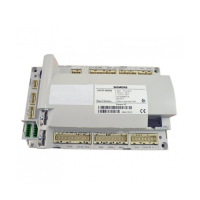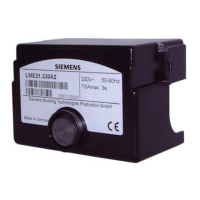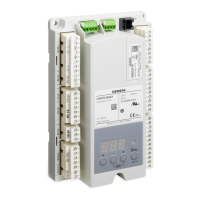Do you have a question about the Siemens LMV27.100x2 and is the answer not in the manual?
Critical warnings for safe operation, installation, and maintenance of the LMV27.
Guidelines and requirements for proper physical mounting of the LMV27 unit.
Key considerations for electrical wiring, cable routing, and installation safety.
Details on SELV, PELV, and FELV electrical connections for the LMV27.
Guidelines for connecting flame detectors to ensure optimal signal transmission and safety.
Essential checks and procedures for safe and correct commissioning of the LMV27 system.
Guidelines for parameter settings, burner identification, and safe operation.
Detailed technical specifications for the LMV27 basic unit.
Specifications for the unit's input terminals and their electrical characteristics.
Specifications for the unit's output terminals and their electrical characteristics.
Technical details and considerations for various types of flame detectors.
Overview of the LMV27's key inputs and outputs, with references to sequence diagrams.
Technical details and considerations for various types of flame detectors.
Procedures and error codes related to loss of flame events and shutdown.
How extraneous light affects operation and triggers errors during different phases.
Error conditions and meanings when no flame is detected within the safety time.
Detailed explanation of digital inputs and their functions.
Input for the safety loop, its components, and error handling.
Input for external load controllers for ON/OFF heat requests.
Inputs for external load controllers for stage control or open/close signals.
Input for the air pressure switch, its function, and parameters.
Input for gas pressure switch for valve proving and related parameters.
Input for minimum gas/oil pressure switches and start release gas function.
Input for maximum gas/oil pressure switches or POC contacts.
Outputs for connecting gas or oil valves, depending on the fuel train type.
Table of time parameters used to adapt fuel train characteristics to applications.
Explanation of valve proving function for gas valves to detect leaks.
Overview of special functions that can occur during the program sequence.
Methods for manually locking the unit or performing a reset via AZL2 or terminals.
List of conditions that cause start prevention, with corresponding error codes.
Functionality of repetition counters for different errors and their impact on lockout.
How the gas shortage program functions, including tests and repetition limits.
Procedure for verifying detection time in loss-of-flame events for burner approval.
Connecting external load controllers via contacts for modulating and multistage operations.
How the LMV27 selects and prioritizes different load controller sources.
Details on modulating operation, actuator control, and output regulation.
Defining air-fuel ratio curves using 10 fixed curvepoints and their assignment.
Adjusting minimum and maximum output settings after curve definition.
Operation specific to oil firing, allowing 2-stage or 3-stage modulation.
Defining air-fuel ratio control via static output points and switch-on/off points.
Crucial notes on setting parameters for air-fuel ratio control, including safety and documentation.
Process of referencing actuators after power-on and during shutdown for position feedback.
Monitoring actuator positions using optical incremental transducers and error detection.
Detecting actuator mixups through mounting and reference point configurations.
Ensuring strict separation between mains voltage and low-voltage sides for load output.
Configuring fuel meters, including pulse valency and reading/resetting readings.
Configuring the LMV27 to operate as a slave on the Modbus protocol.
Classification of errors based on severity and switch-off response.
Overview of the AZL2 unit's display, buttons, and their functions.
Special functions accessible via the AZL2 unit.
How to manually lock the LMV27 and perform a reset.
Controlling the burner output manually via the AZL2 unit.
Storing and transferring settings between the LMV27 and AZL2 for backup and restore.
Step-by-step guide for creating a backup data set.
Step-by-step guide for restoring a backup data set to the LMV27.
Standard display in normal operation and navigation to other levels.
How faults, errors, and lockout conditions are displayed.
Display format for errors and lockout status messages.
Procedure for resetting the unit after an error or lockout.
Display of safety shutdown errors and diagnostic codes.
Display indicating start prevention due to unparameterized or reset operating modes.
Display indicating safety loop or burner flange contact issues.
Navigating through different operational levels (Normal, Info, Service, Parameter) using button combinations.
Accessing and potentially deleting the error history.
Procedure for entering passwords to access parameter levels.
How to enter or modify the burner identification number.
Steps for changing the heating engineer's password, requiring OEM password entry.
Steps for changing the OEM's password.
Navigating and using the parameter level for settings and configuration.
Procedures for initial commissioning and setting fuel/air ratio curves.
Steps for initial commissioning and setting air-fuel ratio control.
Setting curvepoints P0 and P9 for modulating modes.
Setting curvepoints P0 and P9 for pneumatic modulating modes.
Performing warm settings for modulating modes while flame is present.
Editing individual curvepoints for fuel and air actuators.
List of error codes, diagnostic codes, meanings, and recommended measures.
Critical warnings for safe operation, installation, and maintenance of the LMV27.
Guidelines and requirements for proper physical mounting of the LMV27 unit.
Key considerations for electrical wiring, cable routing, and installation safety.
Details on SELV, PELV, and FELV electrical connections for the LMV27.
Guidelines for connecting flame detectors to ensure optimal signal transmission and safety.
Essential checks and procedures for safe and correct commissioning of the LMV27 system.
Guidelines for parameter settings, burner identification, and safe operation.
Detailed technical specifications for the LMV27 basic unit.
Specifications for the unit's input terminals and their electrical characteristics.
Specifications for the unit's output terminals and their electrical characteristics.
Technical details and considerations for various types of flame detectors.
Overview of the LMV27's key inputs and outputs, with references to sequence diagrams.
Technical details and considerations for various types of flame detectors.
Procedures and error codes related to loss of flame events and shutdown.
How extraneous light affects operation and triggers errors during different phases.
Error conditions and meanings when no flame is detected within the safety time.
Detailed explanation of digital inputs and their functions.
Input for the safety loop, its components, and error handling.
Input for external load controllers for ON/OFF heat requests.
Inputs for external load controllers for stage control or open/close signals.
Input for the air pressure switch, its function, and parameters.
Input for gas pressure switch for valve proving and related parameters.
Input for minimum gas/oil pressure switches and start release gas function.
Input for maximum gas/oil pressure switches or POC contacts.
Outputs for connecting gas or oil valves, depending on the fuel train type.
Table of time parameters used to adapt fuel train characteristics to applications.
Explanation of valve proving function for gas valves to detect leaks.
Overview of special functions that can occur during the program sequence.
Methods for manually locking the unit or performing a reset via AZL2 or terminals.
List of conditions that cause start prevention, with corresponding error codes.
Functionality of repetition counters for different errors and their impact on lockout.
How the gas shortage program functions, including tests and repetition limits.
Procedure for verifying detection time in loss-of-flame events for burner approval.
Connecting external load controllers via contacts for modulating and multistage operations.
How the LMV27 selects and prioritizes different load controller sources.
Details on modulating operation, actuator control, and output regulation.
Defining air-fuel ratio curves using 10 fixed curvepoints and their assignment.
Adjusting minimum and maximum output settings after curve definition.
Operation specific to oil firing, allowing 2-stage or 3-stage modulation.
Defining air-fuel ratio control via static output points and switch-on/off points.
Crucial notes on setting parameters for air-fuel ratio control, including safety and documentation.
Process of referencing actuators after power-on and during shutdown for position feedback.
Monitoring actuator positions using optical incremental transducers and error detection.
Detecting actuator mixups through mounting and reference point configurations.
Ensuring strict separation between mains voltage and low-voltage sides for load output.
Configuring fuel meters, including pulse valency and reading/resetting readings.
Configuring the LMV27 to operate as a slave on the Modbus protocol.
Classification of errors based on severity and switch-off response.
Overview of the AZL2 unit's display, buttons, and their functions.
Special functions accessible via the AZL2 unit.
How to manually lock the LMV27 and perform a reset.
Controlling the burner output manually via the AZL2 unit.
Storing and transferring settings between the LMV27 and AZL2 for backup and restore.
Step-by-step guide for creating a backup data set.
Step-by-step guide for restoring a backup data set to the LMV27.
Standard display in normal operation and navigation to other levels.
How faults, errors, and lockout conditions are displayed.
Display format for errors and lockout status messages.
Procedure for resetting the unit after an error or lockout.
Display of safety shutdown errors and diagnostic codes.
Display indicating start prevention due to unparameterized or reset operating modes.
Display indicating safety loop or burner flange contact issues.
Navigating through different operational levels (Normal, Info, Service, Parameter) using button combinations.
Accessing and potentially deleting the error history.
Procedure for entering passwords to access parameter levels.
How to enter or modify the burner identification number.
Steps for changing the heating engineer's password, requiring OEM password entry.
Steps for changing the OEM's password.
Navigating and using the parameter level for settings and configuration.
Procedures for initial commissioning and setting fuel/air ratio curves.
Steps for initial commissioning and setting air-fuel ratio control.
Setting curvepoints P0 and P9 for modulating modes.
Setting curvepoints P0 and P9 for pneumatic modulating modes.
Performing warm settings for modulating modes while flame is present.
Editing individual curvepoints for fuel and air actuators.
List of error codes, diagnostic codes, meanings, and recommended measures.
| Flame safeguard control | Yes |
|---|---|
| Restart interlock | Yes |
| Relay outputs | 4 |
| Application | Burner control |
| Frequency | 50/60 Hz |
| Flame detection | UV, ionization, or IR |
| Temperature Range | -20...+60 °C |
| Ambient temperature | -20...+60 °C |
| Communication | No |












